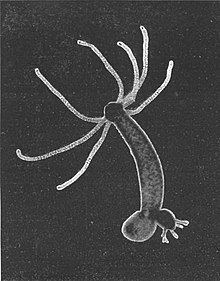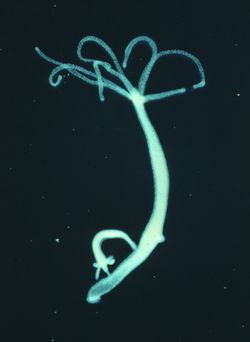Family Hydridae Order Anthomedusae | Suborder Capitata Scientific name Hydra Higher classification Hydridae Rank Genus | |
 | ||
Lower classifications Hydra viridissima, Hydra vulgaris, Hydra oligactis | ||
Living hydra genus super cool
Hydra /ˈhaɪdrə/ is a genus of small, fresh-water animals of the phylum Cnidaria and class Hydrozoa. They are native to the temperate and tropical regions. Biologists are especially interested in Hydra because of their regenerative ability – they appear not to age or die of old age.
Contents
- Living hydra genus super cool
- Morphology
- Motion and locomotion
- Reproduction and life cycle
- Feeding
- Measuring the feeding response
- Morphallaxis
- Non senescence
- Genomics
- References

Morphology

Hydra has a tubular, radially symmetric body up to 10 mm (0.39 in) long when extended, secured by a simple adhesive foot called the basal disc. Gland cells in the basal disc secrete a sticky fluid that accounts for its adhesive properties.

At the free end of the body is a mouth opening surrounded by one to twelve thin, mobile tentacles. Each tentacle, or cnida (plural: cnidae), is clothed with highly specialised stinging cells called cnidocytes. Cnidocytes contain specialized structures called nematocysts, which look like miniature light bulbs with a coiled thread inside. At the narrow outer edge of the cnidocyte is a short trigger hair called a cnidocil. Upon contact with prey, the contents of the nematocyst are explosively discharged, firing a dart-like thread containing neurotoxins into whatever triggered the release which can paralyse the prey, especially if many hundreds of nematocysts are fired.

Hydra has two main body layers, which makes it "diploblastic". The layers are separated by mesoglea, a gel-like substance. The outer layer is the epidermis, and the inner layer is called the gastrodermis, because it lines the stomach. The cells making up these two body layers are relatively simple. Hydramacin is a bactericide recently discovered in Hydra; it protects the outer layer against infection.
The nervous system of Hydra is a nerve net, which is structurally simple compared to mammalian nervous systems. Hydra does not have a recognizable brain or true muscles. Nerve nets connect sensory photoreceptors and touch-sensitive nerve cells located in the body wall and tentacles.
Respiration and excretion occur by diffusion everywhere through the epidermis.
Motion and locomotion
If Hydra are alarmed or attacked, the tentacles can be retracted to small buds, and the body column itself can be retracted to a small gelatinous sphere. Hydra generally react in the same way regardless of the direction of the stimulus, and this may be due to the simplicity of the nerve nets.
Hydra are generally sedentary or sessile, but do occasionally move quite readily, especially when hunting. They have two distinct methods for moving - 'looping' and 'somersaulting'. They do this by bending over and attaching themselves to the substrate with the mouth and tentacles and then relocate the foot, which provides the usual attachment, this process is called looping. In somersaulting, the body then bends over and makes a new place of attachment with the foot. By this process of "looping" or "somersaulting", a Hydra can move several inches (c. 100 mm) in a day. Hydra may also move by amoeboid motion of their bases or by simply detaching from the substrate and floating away in the current.
Reproduction and life cycle
When food is plentiful, many Hydra reproduce asexually by producing buds in the body wall, which grow to be miniature adults and simply break away when they are mature. When a hydra is well fed, a new bud can form every two days. When conditions are harsh, often before winter or in poor feeding conditions, sexual reproduction occurs in some Hydra. Swellings in the body wall develop into either a simple ovary or testes. The testes release free-swimming gametes into the water, and these can fertilize the egg in the ovary of another individual. The fertilized eggs secrete a tough outer coating, and, as the adult dies, these resting eggs fall to the bottom of the lake or pond to await better conditions, whereupon they hatch into nymph Hydra. Some, like Hydra circumcincta and Hydra viridissima, are hermaphrodites and may produce both testes and an ovary at the same time.
Many members of the Hydrozoa go through a body change from a polyp to an adult form called a medusa. However, all Hydra, despite being hydrozoans, remain as polyps throughout their lives.
Feeding
Hydra mainly feed on aquatic invertebrates such as Daphnia and Cyclops.
When feeding, Hydra extend their body to maximum length and then slowly extend their tentacles. Despite their simple construction, the tentacles of Hydra are extraordinarily extensible and can be four to five times the length of the body. Once fully extended, the tentacles are slowly manoeuvred around waiting for contact with a suitable prey animal. Upon contact, nematocysts on the tentacle fire into the prey, and the tentacle itself coils around the prey. Within 30 seconds, most of the remaining tentacles will have already joined in the attack to subdue the struggling prey. Within two minutes, the tentacles will have surrounded the prey and moved it into the opened mouth aperture. Within ten minutes, the prey will have been enclosed within the body cavity, and digestion will have started. Hydra is able to stretch its body wall considerably in order to digest prey more than twice its size. After two or three days, the indigestible remains of the prey will be discharged by contractions through the mouth aperture.
The feeding behaviour of Hydra demonstrates the sophistication of what appears to be a simple nervous system.
Some species of Hydra exist in a mutual relationship with various types of unicellular algae. The algae are protected from predators by Hydra and, in return, photosynthetic products from the algae are beneficial as a food source to Hydra.
Measuring the feeding response
The feeding response in Hydra is known to be induced by reduced glutathione released from the injured prey. There are several methods which are conventionally used for quantification of the feeding response. In some of such methods, the duration for which mouth of Hydra remains open is measured. Whereas, few other methods rely on courting the number of hydra out of a small population showing the feeding response after addition of glutathione. Recently, an assay for measuring the feeding response in hydra has been developed. In this method, the linear two-dimensional distance between the tip of the tentacle and the mouth of hydra was shown to give the direct measure of the extent of feeding response. This method has been validated using a starvation model, as starvation is known to cause enhancement in the feeding response in Hydra.
Morphallaxis
Hydra undergoes morphallaxis (tissue regeneration) when injured or severed.
Non-senescence
Daniel Martinez claimed in a 1998 article in Experimental Gerontology that Hydra are biologically immortal. This publication has been widely cited as evidence that Hydra do not senesce (do not age), and that they are proof of the existence of non-senescing organisms generally. In 2010 Preston Estep published (also in Experimental Gerontology) a letter to the editor arguing that the Martinez data support rather than refute the hypothesis that Hydra senesce.
The controversial unlimited life span of Hydra has attracted the attention of natural scientists for a long time. Research today appears to confirm Martinez' study. Hydra stem cells have a capacity for indefinite self-renewal. The transcription factor, "forkhead box O" (FoxO) has been identified as a critical driver of the continuous self-renewal of Hydra. A drastically reduced population growth resulted from FoxO down-regulation, so research findings do contribute to both a confirmation and an understanding of Hydra immortality.
While Hydra immortality is well-supported today, the implications for human aging are still controversial. There is much optimism; however, it appears that researchers still have a long way to go before they are able to understand how the results of their work might apply to the reduction or elimination of human senescence.
Genomics
A draft of the genome of Hydra magnipapillata was reported in 2010.
